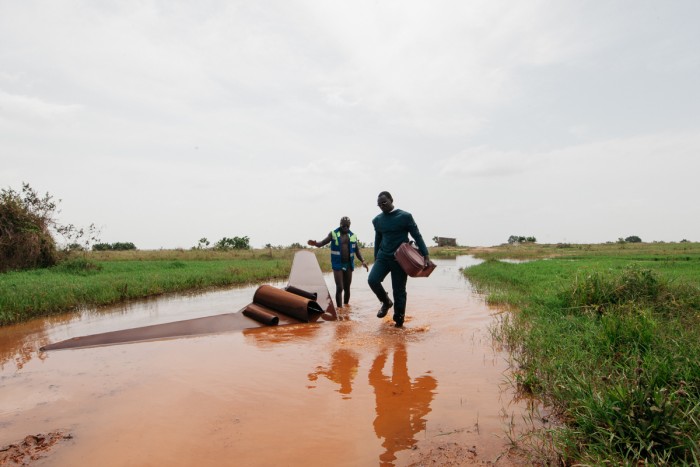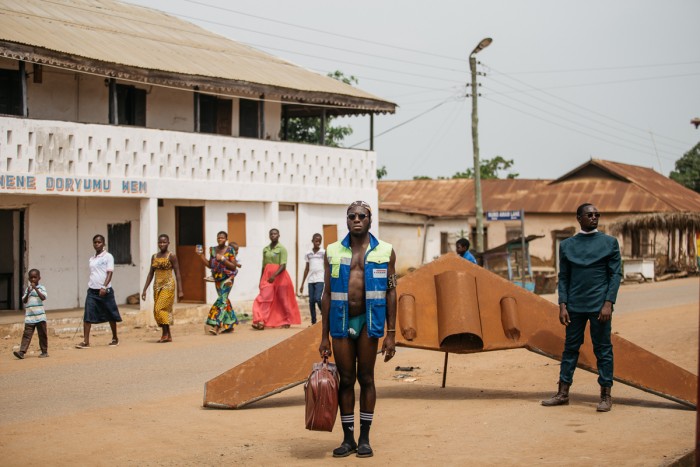Ghanaian photographer Francis Kokoroko believes there is an immeasurable amount of potential locked in his home country. With his photographic essay, The Drone Scrap Program 2054, Kokoroko turns the clock forward to 2054, taking a look at the socio-economic and political factors present in Ghana that could one day be detrimental to the country’s development.
Based in Accra, Kokoroko’s work spans across west Africa. His photographic essay was inspired by a drone created by music producer, Yaw Prempeh. “As friends who usually hang around together, we started having conversations about how we can actually move the project beyond its initial performance and create visuals that people would enjoy and be inspired by,” says Kokoroko.
Taking the drone and dubbing it “The Black Sentinel Ultra,” Kokoroko created a fictional world in which Ghana’s burgeoning space program is curtailed by greed, inadequacy, and corruption.
“We chose to use a fictional story that could highlight the massive potential of our generation and also to bring attention to certain attitudes that are baleful to personal and social progress,” he explains.
Ultimately, Kokoroko hopes the essay will inspire viewers and help them avoid the pitfalls present in daily life.
The project was created in collaboration with Prempeh, performer Evans Mireku Kissi, and stylist Daniel Quist.
The fictional story and its accompanying pictures can be viewed in full below:
The Drone Scrap Program 2054
Drone Model Name: The Black Sentinel Ultra
Built: July 2052
Commissioned: August 2052
Current Year: 2054
Decades down the line, Ghana started a space program that was meant to launch home-made communication satellites into space. The program neglected its main goal of launching these communication technologies and began commercializing the highly sophisticated drone capabilities into illegal surveillance activities. This was very lucrative considering the volatility in the region.
The Drones were built with exquisite precision and employed the best and most creative minds in the country. The Black Sentinel Ultra was modeled after the Sentinel Military Drone and was powered by very little crude, solar and wind energy that will allow it to stay in flight for close to 20 years. Its synthetic metal fabricated casing was designed to absorb sunlight and lightning to store power in tiny energy cells.
Revenue generated by The Program was squandered by the appointed officers of the ruling party and the case ended up at the Supreme Court. It is still being debated as to who is solely responsible for this massive USD 213.2 billion dollar financial loss to the State.
This happened at a time when Ghana had ambitions to prove to the region and the world that it was a country capable of competing with the strongest economies on the continent; Tanzania, South Africa, Nigeria & Rwanda. The economy took a downturn after taxes had been raised in an attempt to retrieve some of the monies that had been lost.
The Black Sentinel Ultra was highly successful after its first mission but negligence, illegal and unauthorized use of the drones at the control center caused it to break down beyond repair. It was kept in a makeshift hanger at the defunct Kotoka International Airport and started to deteriorate.
Scrap businesses started coming by to bid over the heavy metal pieces to sell which was very lucrative due to the industrial demand for the high-quality synthetic metal which they would melt down, mix and resell.
Using the blueprint of The Black Sentinel Ultra, two creative artists came together to fix and re-test it. The restoration of the derelict project looks promising but it is becoming increasingly expensive to keep it going.














